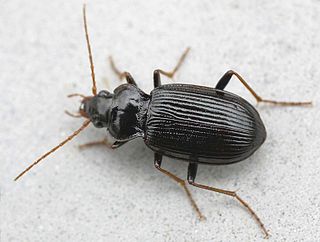Related Research Articles

Nebria is a genus of ground beetles native to the Palearctic, the Near East and North Africa. There are more than 500 described species in Nebria.

Nebria brevicollis is a species of ground beetle native to Europe and the Near East. In Europe, it is found in all countries and islands except the Azores, the Canary Islands, the Channel Islands, Franz Josef Land, Gibraltar, Madeira, Malta, Monaco, the North Aegean Islands, Novaya Zemlya, San Marino, the Selvagens Islands, Svalbard and Jan Mayen, and Vatican City. It has now been reported as introduced in western Oregon, U.S.A., where it has been found in highly disturbed sites as well as in native old-growth forest stands. It has also now been found in Washington State, Northern California, as well as in Southern British Columbia, Canada(See external link to iNaturalist, below). This species is most abundant between October and December, then from January through mid-May. Although Nebria brevicollis is widely considered to be solely carnivorous, multiple small studies made by enthusiasts have proven that many Nebria brevicollis will resort to eating various types of fungi that can be found in the soil they live on/around. Studied made by the same individuals have also shown that Nebria brevicollis are semi-social, and will often work together when faced with certain obstacles.

Nebria livida is a species of ground beetle with two subspecies:

Nebriinae is a subfamily of ground beetles in the family Carabidae. There are about 12 genera and more than 840 described species in Nebriinae.
Nebria aetolica is a species of ground beetle in the Nebriinae subfamily that can be found in Albania, Greece, and North Macedonia.
Nebria dahlii is a species of ground beetle in the Nebriinae subfamily that can be found in Austria, all states of former Yugoslavia, and Italy.
Nebria fuscipes is a species of ground beetle in the Nebriinae subfamily that can be found in Hungary, Poland, Romania, Slovakia, and Ukraine. The species is black coloured and is 13 millimetres (0.51 in) long.
Nebria peristerica is a species of ground beetle in the Nebriinae family that can be found in Greece and North Macedonia.
Nebria punctatostriata is a species of ground beetle in the Nebriinae subfamily that can be found in Portugal and Spain.
Nebria reichii is a species of ground beetle in the Carabinae subfamily that is endemic to Romania.
Nebria rubripes is a species of ground beetle in the Nebriinae subfamily that can be found in France and Spain.
Nebria tatrica is a species of ground beetle in the Nebriinae subfamily that can be found in Poland Czech Republic and Slovakia.
Nebria lariollei is a species of beetle in the family Carabidae that is endemic to France.
Nebria laticollis is a species of ground beetle in the Nebriinae subfamily that can be found in France, Italy, and Switzerland.
Nebria angusticollis is a species of ground beetle in Nebriinae subfamily that can be found in the Alps of France, Italy, and Switzerland.
Nebria cordicollis is a species of black coloured ground beetle from Nebriinae subfamily that can be found in Switzerland, Italy, and Germany. The species is about 5 millimetres (0.20 in) long.
Nebria elbursiaca is a species of ground beetle in the Nebriinae subfamily that is endemic to Iran.
Aenictus currax is a species of dark brown army ant found on New Guinea. A colony of 100,000+ was chronicled on New Guinea in Karema, PNG. The ants form new colonies through fission.
Tyrrhenia may refer to:
References
- ↑ "Nebria currax Wollaston, 1864". Catalogue of Life. Retrieved 2023-04-08.